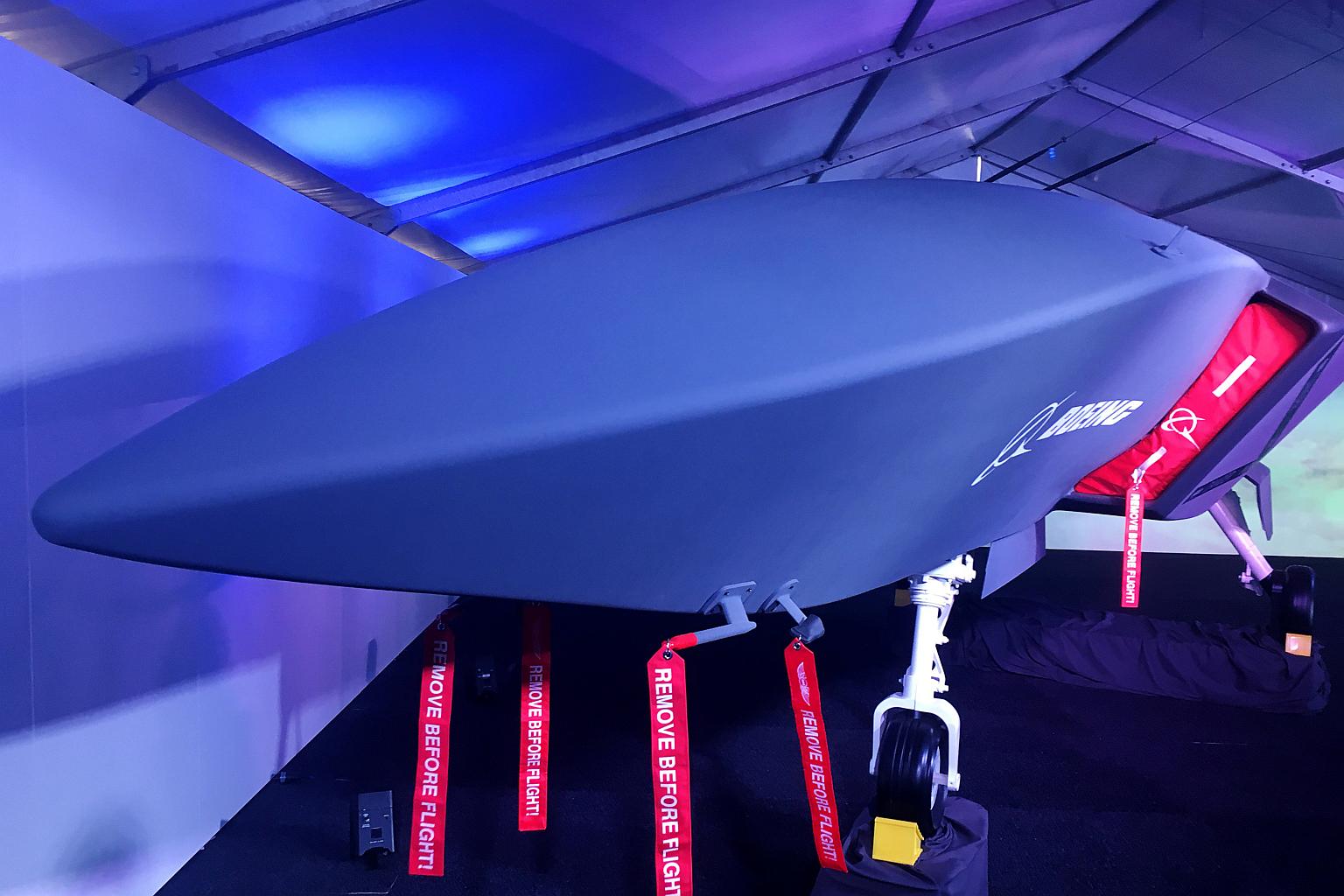Boeing unveils unmanned combat jet developed in Australia
Sign up now: Get insights on Asia's fast-moving developments

A model of Boeing's new unmanned, fighter-like jet, called the Boeing Airpower Teaming System, is displayed in Avalon, Australia, on Feb 27, 2019.
PHOTO: REUTERS
Follow topic:
AVALON, AUSTRALIA (REUTERS) - Boeing Co on Wednesday (Feb 27) unveiled an unmanned, fighter-like jet developed in Australia and designed to fly alongside crewed aircraft in combat for a fraction of the cost.
The US manufacturer hopes to sell the multi-role aircraft, which is 11.6m long and has a 3,704km range, to customers around the world, modifying it as requested.
The prototype is Australia's first domestically developed combat aircraft since World War II and Boeing's biggest investment in unmanned systems outside the United States, although the company declined to specify the dollar amount.
The Australian government is investing A$40 million (S$38.71 million) in the prototype programme due to its "enormous capability for exports," Minister for Defence Christopher Pyne told reporters at the Australian International Airshow.
Defence contractors are investing increasingly in autonomous technology as militaries around the world look for a cheaper and safer way to maximise their resources.
Boeing rivals like Lockheed Martin Corp and Kratos Defense and Security Solutions Inc are also investing in such aircraft.
Four to six of the new aircraft, called the Boeing Airpower Teaming System, can fly alongside a F/A-18E/F Super Hornet, said Shane Arnott, director of Boeing research and prototype arm Phantom Works International.
"To bring that extra component and the advantage of unmanned capability, you can accept a higher level of risk," he said. "It is better for one of these to take a hit than for a manned platform."
The Mitchell Institute for Aerospace Studies in the US said last year that the US Air Force should explore pairing crewed and uncrewed aircraft to expand its fleet and complement a limited number of "exquisite, expensive, but highly potent fifth-generation aircraft" like the F-35.
"Human performance factors are a major driver behind current aerial combat practices," the policy paper said. "Humans can only pull a certain number of G's, fly for a certain number of hours, or process a certain amount of information at a given time."
MULTI-MISSION CAPABILITIES
In addition to performing like a fighter jet, other roles for the Boeing system include electronic warfare, intelligence, surveillance and reconnaissance alongside aircraft like the P-8 Poseidon and E-7 Wedgetail, said Kristin Robertson, vice-president and general manager of Boeing Autonomous Systems.
"It is operationally very flexible, modular, multi-mission,"she said. "It is a very disruptive price point. Fighter-like capability at a fraction of the cost."
Ms Robertson declined to comment on the cost, saying that it would depend on the configuration chosen by individual customers.
The jet is powered by a derivative of a commercially available engine, uses standard runways for take-off and landing, and can be modified for carrier operations at sea, Ms Robertson said. She declined to specify whether it could reach supersonic speeds, common for modern fighter aircraft.
Its first flight is expected in 2020, with Boeing and the Australian government producing a concept demonstrator to pave the way for full production.
"I would say we are some years away from exports, we are probably years away from it being in operation here in Australia," Mr Pyne said. "It is designed to be a cheaper platform, a shield if you like around the more expensive platforms, to protect our servicemen and women who might be on a Poseidon or a Wedgetail or a F-35A."
Australia, a staunch US ally, is home to Boeing's largest footprint outside the US and has vast airspace with relatively low traffic for flight testing.
The Boeing Airpower Teaming System will be manufactured in Australia, but production lines could be set up in other countries depending on sales, Mr Arnott said.
The US, which has the world's biggest military budget, would be among the natural customers for the product.
The US Air Force 2030 project foresees the Lockheed Martin F-35A Joint Strike Fighter working together with stealthy combat drones, called the "Loyal Wingman" concept, said Derrick Maple, principal analyst for unmanned systems at IHS Markit.
"The US has more specific plans for the wingman concept, but Western Europe will likely develop their requirements in parallel, to abate the capabilities of China and the Russian Federation and other potential threats," he said.
Ms Robertson declined to name potential customers and would not comment on potential stealth properties, but said the aircraft had the potential to sell globally.
"We didn't design this as a point solution but a very flexible solution that we could outfit with payloads, sensors, different mission sets to complement whatever their fleet is,"she said. "Don't think of it as a specific product that is tailored to do only one mission."

